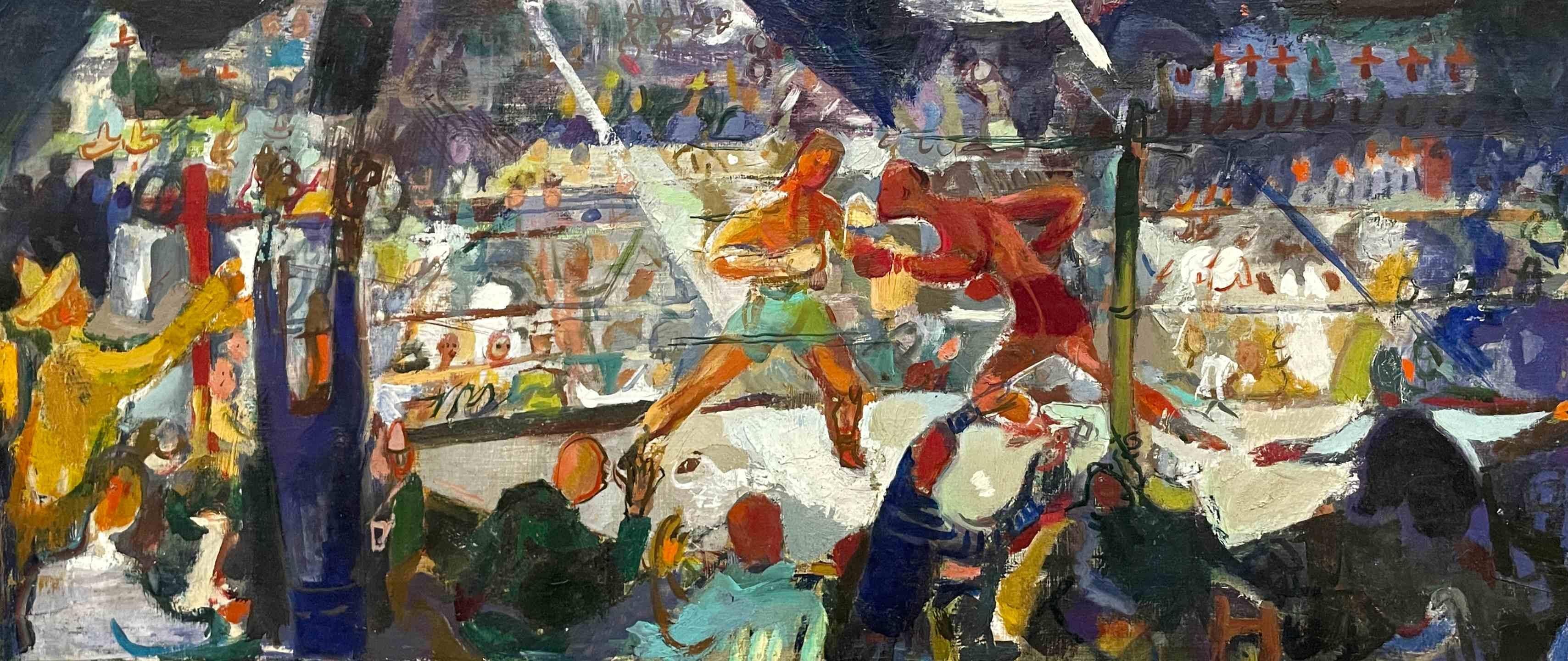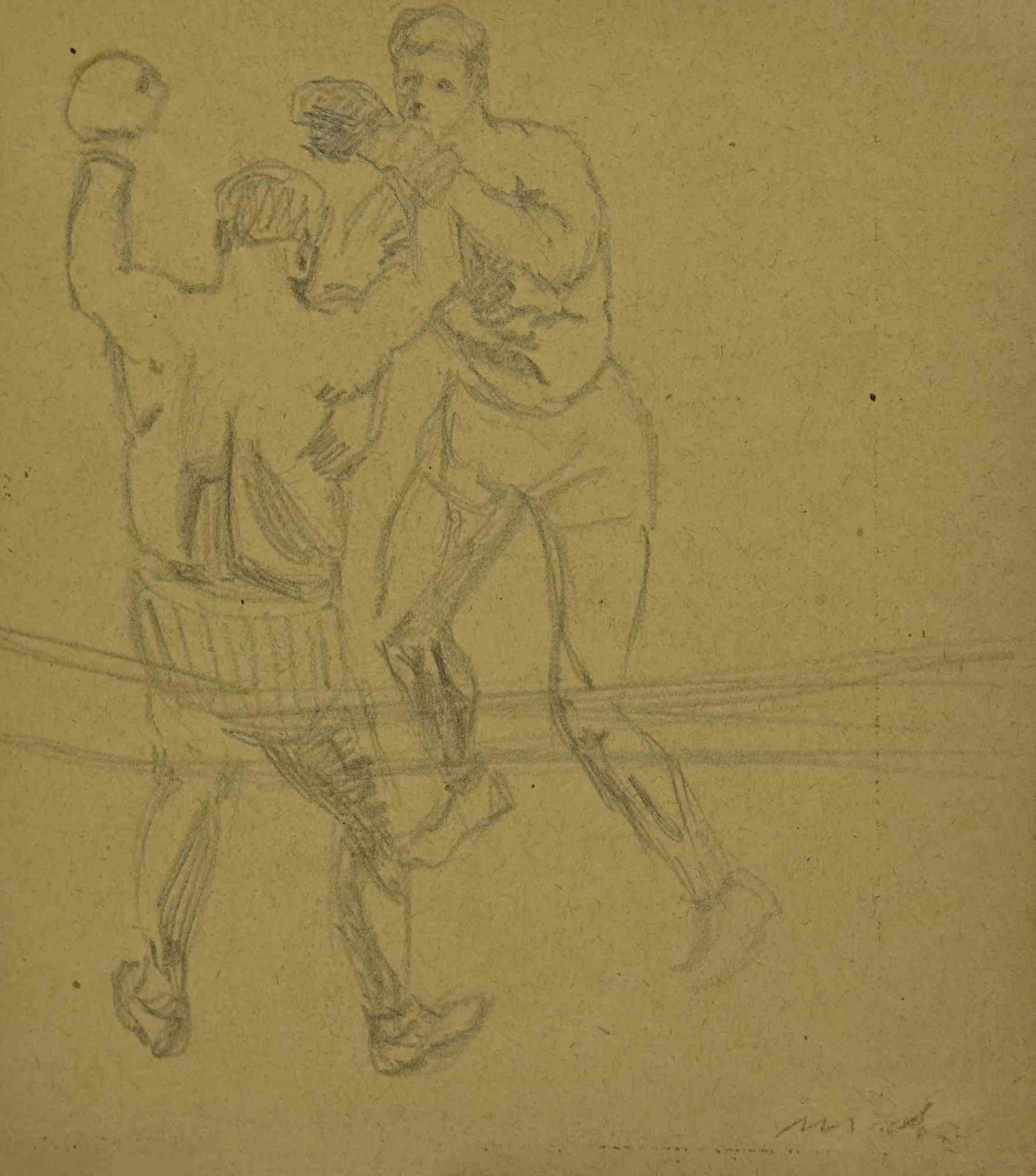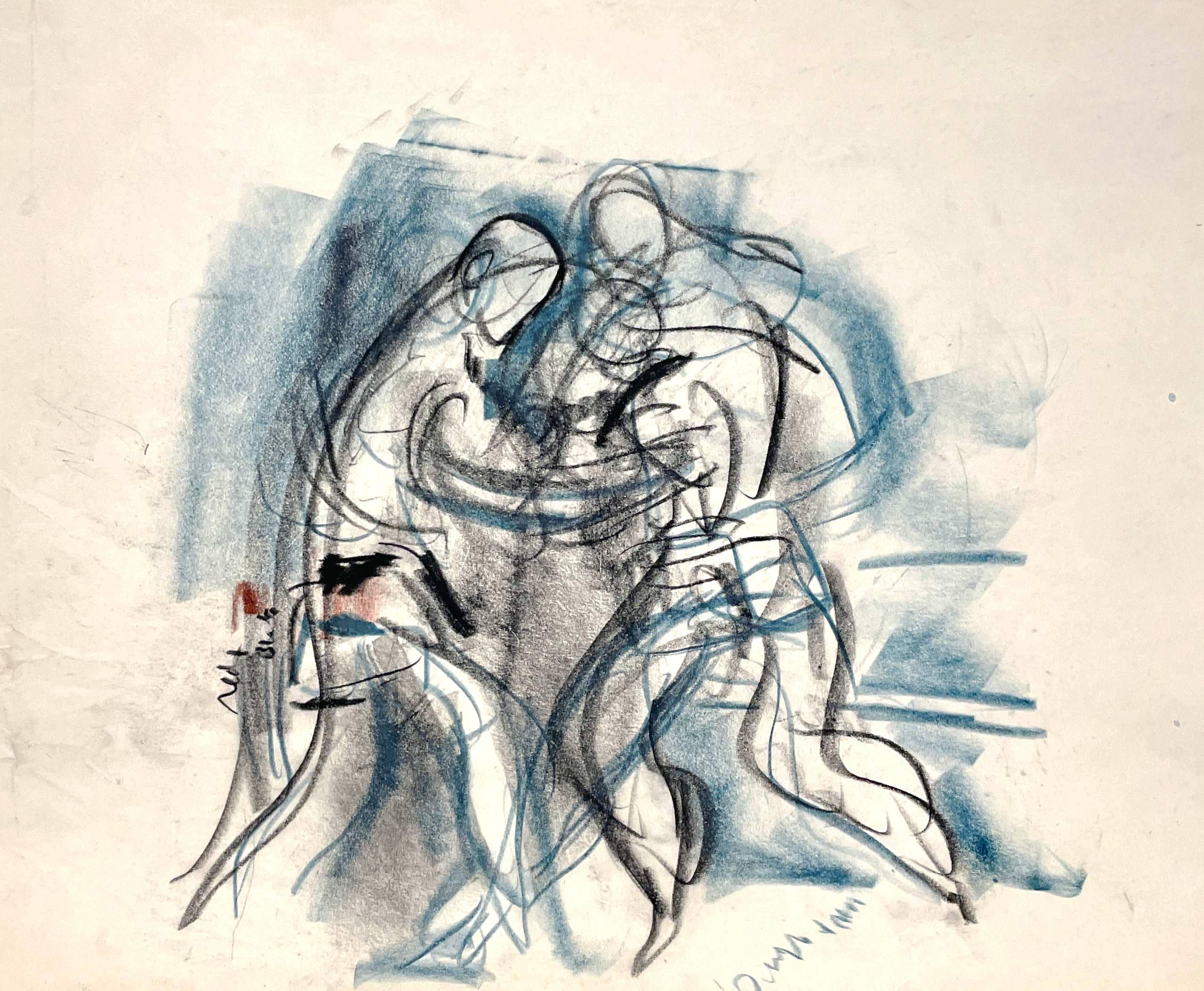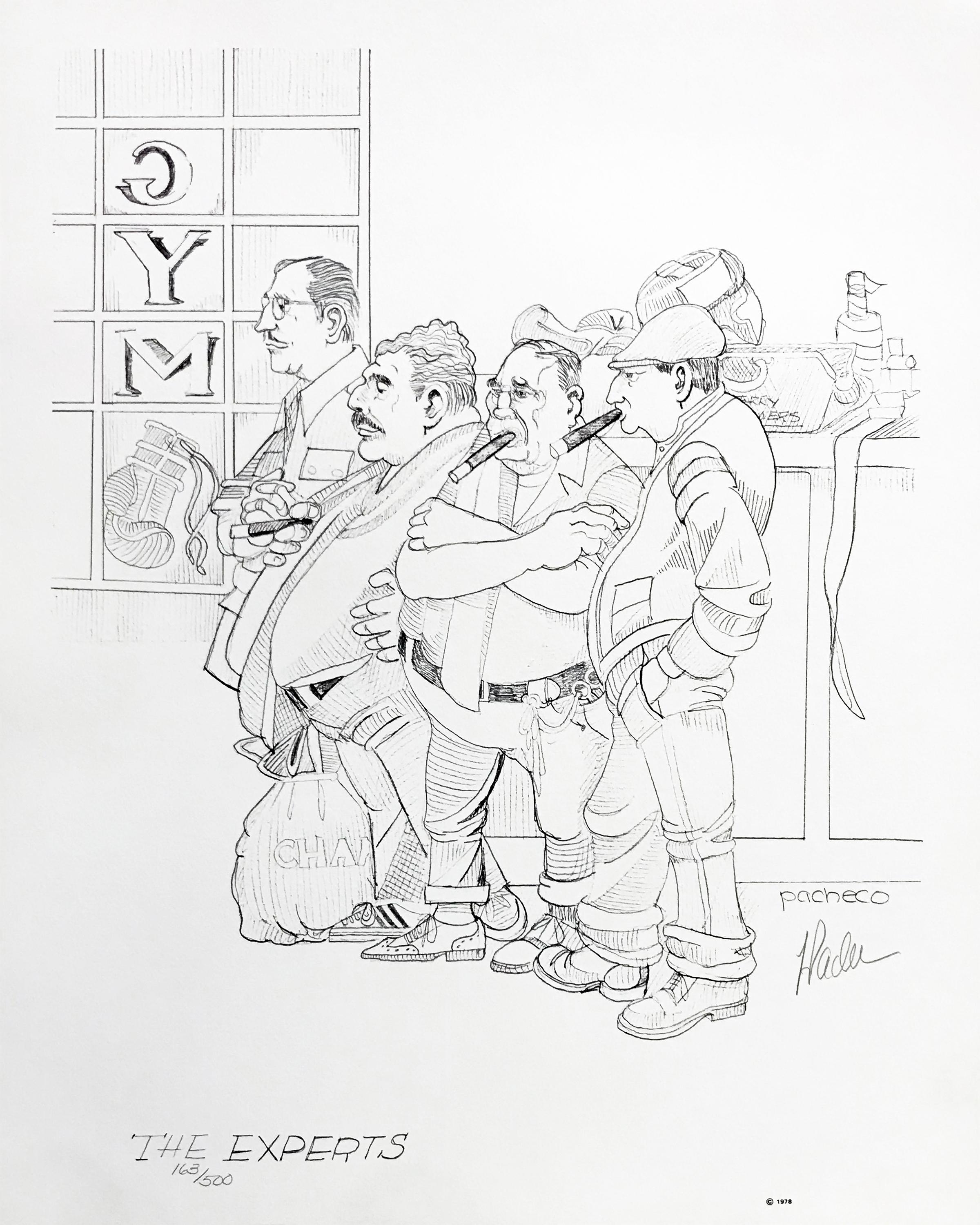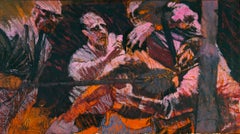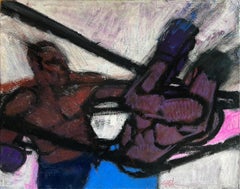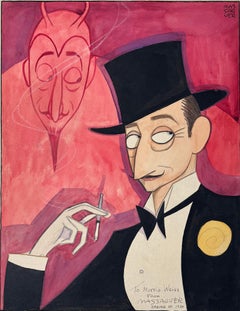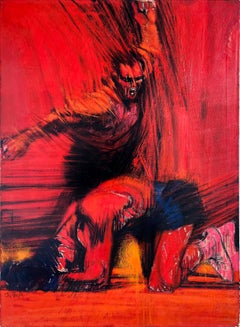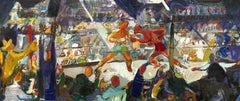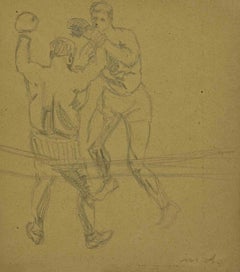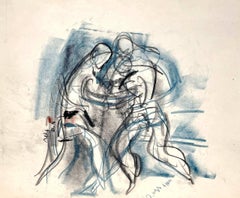Items Similar to Charles de Gaulle Boxing Match Political Cartoon - Cuban Artist
Video Loading
Want more images or videos?
Request additional images or videos from the seller
1 of 19
Conrado MassaguerCharles de Gaulle Boxing Match Political Cartoon - Cuban Artist1945
1945
$10,000
£7,753.70
€8,798.03
CA$14,334.57
A$15,586.80
CHF 8,212.72
MX$189,334.44
NOK 103,250.52
SEK 96,789.02
DKK 66,021.54
About the Item
The present work features Charles de Gaulle in a boxing match in a political cartoon, facing an unidentified opponent with Spanish-language thought balloons.
Untitled
signed and dated 'Massaguer 1945' (lower right); inscribed '21. Octobre 1945' (center right)
watercolor, colored pencil and pen and ink on cardboard
15 x 22 in (38.1 x 55.8 cm)
Executed in 1945
Provenance
José Viegas Zamora Collection, Havana.
Acquired from the above by the present owner.
Bonhams
- Creator:Conrado Massaguer (1889 - 1965, Cuban)
- Creation Year:1945
- Dimensions:Height: 15 in (38.1 cm)Width: 22 in (55.88 cm)
- Medium:
- Period:
- Condition:Overall a good condition a few minor creases mostly visible with raking light. Some minor desaturation of color.
- Gallery Location:Miami, FL
- Reference Number:1stDibs: LU385317132942
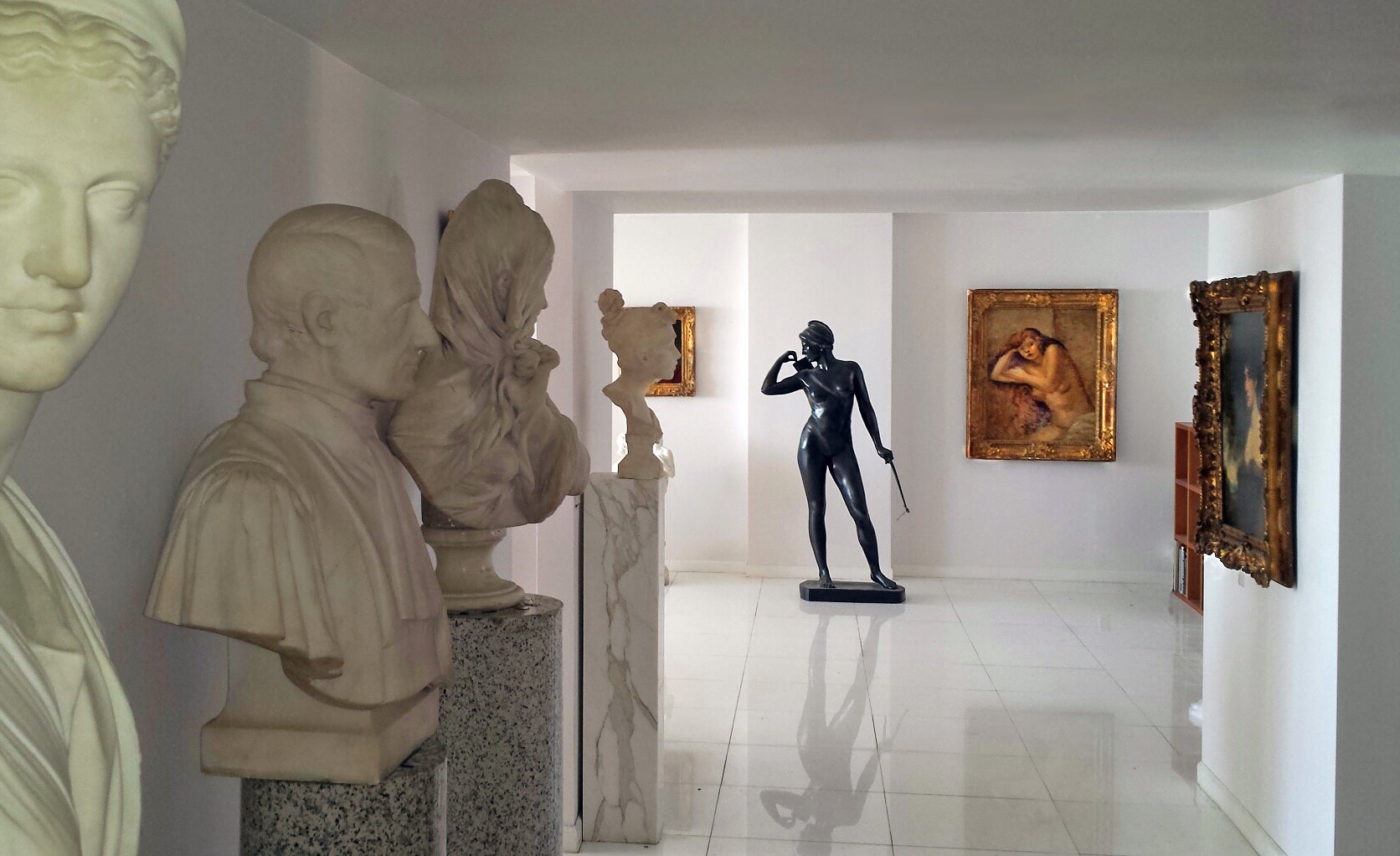
About the Seller
5.0
Vetted Professional Seller
Every seller passes strict standards for authenticity and reliability
Established in 2005
1stDibs seller since 2016
117 sales on 1stDibs
Typical response time: 1 hour
- ShippingRetrieving quote...Shipping from: Miami, FL
- Return Policy
Authenticity Guarantee
In the unlikely event there’s an issue with an item’s authenticity, contact us within 1 year for a full refund. DetailsMoney-Back Guarantee
If your item is not as described, is damaged in transit, or does not arrive, contact us within 7 days for a full refund. Details24-Hour Cancellation
You have a 24-hour grace period in which to reconsider your purchase, with no questions asked.Vetted Professional Sellers
Our world-class sellers must adhere to strict standards for service and quality, maintaining the integrity of our listings.Price-Match Guarantee
If you find that a seller listed the same item for a lower price elsewhere, we’ll match it.Trusted Global Delivery
Our best-in-class carrier network provides specialized shipping options worldwide, including custom delivery.More From This Seller
View AllBoxing Scene. Vanquished Boxer in his Corner. Sports Illustrated Boxing Story
By Bob Peak
Located in Miami, FL
Many in the art world today dismiss illustrators as being commercial simply because their work was done on assignment for a client, rather than for themselves. Sadly, these art world people have limited imagination and a restricted sense of curiosity. Rembrandt and Leonardo were commercial artists. This boxing illustration/painting was done for Sports Illustrated...
Category
1960s Abstract Expressionist Figurative Paintings
Materials
Watercolor, Pencil, Gouache
Boxer Knockout Punch - Esquire Magazine Mid- Century Sports - Action Painting
By Bob Peak
Located in Miami, FL
Brilliant American Illustrator Bob Peak captures the fury and power of a punch to the face with rapid broad strokes of the brush. Combined with a somber color scheme and gestural bru...
Category
1960s Abstract Expressionist Figurative Paintings
Materials
Acrylic, Masonite
Cuban Artist - Caricature of Adolphe Menjou Debonair Devil
Located in Miami, FL
Framed Cuban Artist/Caricaturist Conrado Walter Massaguer presents Hollywood star Adolphe Menjou in a satirical dual portrait. In the foreground, the subject is seen in a dapper top hat, tux, fashionable cigarette and boutonnière, and is shown as being the epitome of being stylishly debonair. To make a larger point about this subject, Massaguer paints a cast shadow of Menjou as a burning red devil who studies his alter ego from above. Keeping with the artist's sarcasm, we see the good and bad in one image. Works by Massaguer are rare and this work is in keeping with his signature style. This work was most likely done on assignment for Life Magazine, Cosmopolitan, The New Yorker or Vanity Fair. Signed upper right. Inscribe lower right. Titled on verso. Unframed, Slight bend to board; toning to board; scattered faint foxing; pin point abrasions to margins, not affecting image. 19-1/2 x 15-1/8 inches board size.
Conrado Walter Massaguer y Diaz was a Cuban artist, political satirist, and magazine publisher. He is considered a student of the Art Nouveau. He was the first caricaturist in the world to broadcast his art on television.He was first caricaturist to exhibit on Fifth Avenue. He was the first caricaturist in the world to exhibit his caricatures on wood. He, and his brother Oscar, were the first magazine publishers in the world to use photolithographic printing.
Self portrait of Conrado Walter Massaguer, depicted on a carrousel ride, with the devil over his left shoulder and an angel over his right. (1945)
He created the magazine Social with his brother Oscar to showcase Cuban artistic talent. The duo later created the magazine Carteles, which became for a period the most popular magazine in Cuba, which was purchased by Miguel Ángel Quevedo in 1953.
In his life, he met and drew caricatures of Franklin D. Roosevelt, Walt Disney, Albert Einstein, the King of Spain, and many others.[ In sum total, he was the author of more than 28 thousand caricatures and drawings.Ernest Hemingway once had to refrain himself from punching Massaguer in the face after the artist drew an unflattering caricature of him. The dictator Gerardo Machado, however, did not punch Massaguer for his own unflattering caricature - he had the artist deported.
He was one of the most internationally renowned Cuban artists of his day, and his art is still regularly featured in galleries across the Western Hemisphere and Europe.
Early life
Massaguer was born on October 18, 1889, in Cárdenas, Cuba.[In 1892, his family moved to Havana.
When the Cuban War of Independence broke out, Massaguer's family escaped the country. From 1896 to 1908, he lived in Mérida, Mexico. However, during this time, his parents enrolled him in the New York Military Academy, where he stayed during school years.
In 1905, after graduating the military academy, he briefly attended the San Fernando school in Havana, where he was tutored by Ricardo de la Torriente and Leopoldo Romañach.
In 1906, less than a year later, he returned to the family home in Mexico.
Career as artist
Early career
While living in Yucatán, Mexico, Massaguer published his first caricatures in local newspapers and magazines. These included La Campana, La Arcadia, and the Diario Yucateco.
In 1908, he moved back to Havana. After returning to the island in 1908, Massaguer began mingling with Havana's aristocratic circles, forming close friendships with some of the city's most powerful and influential men, as well as winning the favor of many women who were quickly charmed by him. Massaguer, largely self-taught, honed his style using the avant-garde techniques he studied from the European and American magazines that were widely available in Cuba at the time.
Cover of the immensely popular Cuban magazine El Figaro, drawn by Massaguer in 1909. This cover depicts two bumbling, incompetent American tourists to the island.
He started drawing for El Fígaro, and was featured prominently on the cover in 1909.
After two years of refining his craft, Havana announced a poster contest aimed at attracting North American tourists to stay in the city during the winter months. Notable figures like Leopoldo Romañach, Armando Menocal, Rodríguez Morey, Jaime Valls, and others also entered the competition. The jury was particularly impressed by the modern execution and creative solution of one piece, signed by Massaguer, who was relatively unknown at the time.
The jury deliberations caused a great controversy.[5] The prize was ultimately awarded to the Galician painter Mariano Miguel, who had recently married the daughter of Nicolás Rivero, the wealthy owner of the conservative newspaper Diario de la Marina. Although Massaguer received only an honorable mention, the fraud scandal caused such an uproar that his name quickly entered the public spotlight, and he became an overnight sensation.
In 1910, he became co-owner of the advertising agency Mercurio, with Laureano Rodríguez Castells. At Mercurio, he led the Susini cigar campaign, and earned substantial wealth.
Massaguer has been described as a restless man, in both mind and body.After earning enough money from his art to begin traveling, he was almost always doing so. He constantly traveled between New York City and Havana, Mexico and France, Europe and the Americas.
In 1911, his reputation among the Havana socialites solidified when he organized his own first public caricature exhibit, and also the first Caricature Salon ever held in the Americas, hosted at Athenaeum of Havana (the Ateneo), and the Círculo de La Habana. Other exhibitors here included Maribona, Riverón, Portell Vilá, Valer, Botet, Barsó, García Cabrera, Carlos Fernández, Rafael Blanco, and Hamilton de Grau.
"Messaguer Visits Broadway." Caricatures of theatrical and literary figures. Elsie Janis, Raymond Hitchcock, S. Jay Kaufman (columnist), Ibanez, author of The Four Horsemen, and Frances White
In 1912, in the New York American Journal, he published his first Broadway drawings.
From 1913 to 1918, he was an editor for Gráfico.
Social
Main article: Social (magazine)
Cover of the magazine Social, July 7, 1923
In 1916, he created the magazine Social with his brother, Oscar H. Massaguer. Social's contributors included Guillén Carpentier, Chacón y Calvo, Enrique José Varona and others.Social has been described as Massaguer's great love in the magazine industry, and was the property that historians say he cared the most about. Social was an innovative magazine, being the first magazine in the world to use a modern printing process called photolithographic printing.
Social set cultural trends, not only in the fashion of Cuba, but in art, politics, and Cuban identity.[11] Social catered to a certain aesthetic in Cuba - that of the sophisticated elite socialite - but Massaguer would also use this magazine to ridicule and jibe against that same class of society when he found their personalities worthy of his contempt.
In Social, readers could find a variety of content, including short stories, avant-garde poetry, art reviews, philosophical essays, and serialized novels, as well as articles on interior design, haute couture, and fashion. Occasionally, the magazine also featured reports on sports such as motor racing, rowing, tennis, and horse riding.The cultural promotion efforts of both Massaguer and Emilio Roig de Leuchsenring are evident in the magazine. Notably, this period overlaps with their involvement in the Minorista Group, which was then at the forefront of the country's intellectual life.[5] Many contributors were devoted members of the group, leading some experts to consider Social as the cultural voice of the Minoristas.
One of the features of Social magazine was its section called "Massa Girls," which was a play on his own name, and pronounced with a glottal 'g' in a similar fashion to the letter in Massaguer.[12] Massaguer drew women as independent and free-thinking, and never drew the woman celebrity as a caricature of herself, but as a free agent surrounded by caricatures.[11] However, Massaguer himself has been described as a womanizer in his personal life, and hesitant to fully embrace every facet of women's liberation.
In 1916, he also established la Unión de Artes Gráficas and the advertising agency Kesevén Anuncios.[9]
The art critic Bernardo González Barroa wrote:
“Massaguer has solved the problem of working hard, living comfortably off what his art produces and not missing any artistic, sporting or social event. His broad, childish laugh, of a carefree individual who carries his luck hidden in a pocket, appears everywhere for the moment, disguising the pranks of pupils that lurk, mock and, finally, flash with satisfaction at finding the characteristic point after having analyzed a soul... Massaguer's personality is beginning to solidify now. He has been the best-known and most popular caricaturist for a long time, but his technique had not reached the security, the mastery of values that he presents in his latest works, which is very natural and explainable”[5]
Carteles
Main article: Carteles
Cover of the magazine Carteles, November 29, 1931
In 1919, Massaguer and his brother created the magazine Carteles.[9] Carteles gained the widest circulation of any magazine in Latin America, and the most popular magazine in Cuba for a time, until that title was claimed by Revista Bohemia. Carteles remained in print until July 1960.This magazine showcased Cuban commerce, art, sports, and social life before the revolution.
In 1924, Carteles took a more political turn, with articles criticizing Gerardo Machado's government. it became a prime example of the humor and graphic design employed by artists like Horacio Rodríguez Suria and Andrés García...
Category
1930s Art Nouveau Portrait Drawings and Watercolors
Materials
Watercolor, Ink, Illustration Board
Boxing Ring. Boxed Knocked to Floor with 10 Count, Red and Black, Esquire Mag
By Bob Peak
Located in Miami, FL
Illustration legend Bob Peak depicts a boxer that has fallen to the matt and is being given the 10-count by the referee. Peak captures that peak moment of drama and then exaggerates...
Category
1960s Expressionist Figurative Paintings
Materials
Canvas, Acrylic
Art Lovers and Art Critics Analyzing Obscene Painting. Cartoon
By Richard Taylor
Located in Miami, FL
Cartoonist Richard Taylor was trained in academic art. He frequently comments on abstract art which was the new and radical thing at the time. "Curtis sees so much more in these thi...
Category
1940s Academic Portrait Drawings and Watercolors
Materials
Ink, Board
The Bully - Narrative Art by Female Illustrator Golden Age of Illustration
By Maginel Wright Enright Barney
Located in Miami, FL
The present work exhibits a storytelling and illustration art style created before the mass communications age. It was rendered in a flat linear style by the highly talented Maginel ...
Category
1910s American Impressionist Figurative Drawings and Watercolors
Materials
India Ink, Watercolor, Board
You May Also Like
A ca. 1935 Painting of a Boxing Match in Mexico City by Artist Francis Chapin
By Francis Chapin
Located in Chicago, IL
A ca. 1935 painting of a boxing match in Mexico by artist Francis Chapin. Image size: 12" x 28". Framed size: 15 1/2" x 31 1/2". Provenance: Estate of the artist.
Francis Chapin, affectionately called the “Dean of Chicago Painters” by his colleagues, was one of the city’s most popular and celebrated painters in his day. Born at the dawn of the 20th Century in Bristolville, Ohio, Chapin graduated from Washington & Jefferson College near Pittsburgh, Pennsylvania before enrolling at the Art Institute of Chicago in 1922. He would set down deep roots at the Art Institute of Chicago, exhibiting there over 31 times between 1926 and 1951. In 1927 Chapin won the prestigious Bryan Lathrop Fellowship from the Art Institute – a prize that funded the artist’s yearlong study trip to Europe. Upon his return to the United States, Chapin decided to remain in Chicago, noting the freedom Chicago artists have in developing independently of the pressure to conform to pre-existing molds (as was experienced by artists in New York, for example). Chapin became a popular instructor at the Art Institute, teaching there from 1929 to 1947 and at the Art Institute’s summer art school in Saugatuck, Michigan (now called Oxbow) between 1934 – 1938 (he was the director of the school from 1941-1945). Chapin’s contemporaries among Chicago’s artists included such luminaries as Ivan Le Lorraine Albright...
Category
1930s American Modern Figurative Paintings
Materials
Canvas, Oil
Boxing - Drawing - Mid-20th Century
Located in Roma, IT
Boxing is a drawing realized in the Mid-20th Century.
Pencil on ivory-colored paper
Good conditions with slight foxing.
The artwork is realized through deft expressive strokes.
Category
Mid-20th Century Modern Figurative Drawings and Watercolors
Materials
Pencil, Paper
"The Knockout" Boxing Sports American Watercolor WPA Mid-Century Modern 30s/40s
By Robert Riggs
Located in New York, NY
"The Knockout" Boxing Sports American Watercolor WPA Mid-Century Modern 30s/40s.
Robert Riggs (1896-1970)
The Knockout
22 x 30 inches watercolor on paper
Signed lower right
Framed: ...
Category
1930s American Modern Figurative Drawings and Watercolors
Materials
Paper, Watercolor
A Fine 1930's, Depiction of a Boxing Match
By Francis Chapin
Located in Chicago, IL
A Fine 1930's, Depiction of a Boxing Match by Francis Chapin. This dynamic drawing captures overlapping human forms rendered in expressive, gestural lines. There is a clear sense of ...
Category
1930s American Modern Figurative Drawings and Watercolors
Materials
Charcoal, Paper, Pastel
THE EXPERTS (BOXING)
Located in Aventura, FL
Offset lithograph in colors on paper. Hand signed and numbered by the artist. From the edition of 500.
Artwork is in excellent condition. Certificate of authenticity included. Al...
Category
Late 20th Century Contemporary Figurative Prints
Materials
Paper, Lithograph
$100 Sale Price
50% Off
Fighter Boxing Woodstock American Scene WPA Era Mid 20th Century Social Realism
Located in New York, NY
Fighter Boxing Woodstock American Scene WPA Era Mid 20th Century Social
John Ruggles (1907-1991)
Sight: 17 1/2 x 13 1/3 inches.
Framed: 22 x 18 inches...
Category
1930s American Realist Figurative Drawings and Watercolors
Materials
Oil, Board
